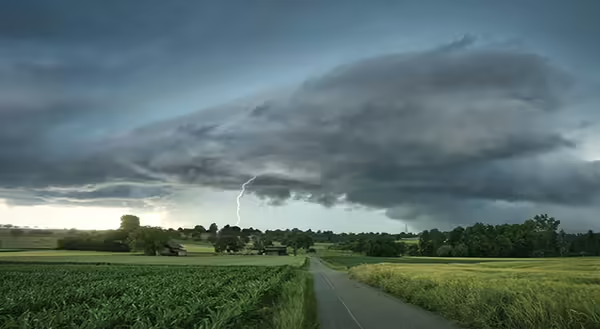
While I was home from college one summer, an early morning thunderstorm passed over our farmhouse. I was in my room, trying to sleep through the storm, while my parents were in the living room. At the peak of the storm, a tremendous boom rattled the house. I then heard my parents frantically moving around, and though I couldn’t exactly hear what was being said, they were very concerned.
What happened was that a lightning strike occurred right outside the house next to the living room. Electricity shot out of an outlet and caught nearby curtains on fire. Luckily my parents were able to smother the fire before it did significant damage. One lasting result from this was my mom’s hearing being affected, as she was just inside where the lightning struck. Her hearing never fully recovered, or at least that’s what she told me when I talked to her.
Understanding Thunder
You hear it in the distance as a gentle rumbling. You hear it as a large clap or peal when it’s close. Thunder always accompanies lightning. It’s a fascinating feature of thunderstorms that is often misunderstood.
When lightning occurs, the air in the electrical channel is immediately heated to upwards of 40,000 degrees. This superheated air rapidly expands, creating a shock wave. The shock wave can knock down a person within 30 to 50 feet of a strike. As the shock wave spreads out, it quickly degrades into a sound wave that we call thunder. Contrary to some beliefs, lightning does not create a vacuum.
The sharpness of thunder depends on how far away it is. Sound waves weaken as they move outward. That’s why you can’t hear thunder from lightning that’s more than about 10 miles away. Thunder will be a sharp crack or clap when lightning is close. A rumbling sound may follow this.
Most cloud-to-ground lightning bolts are 3 to 4 miles from top to bottom. When you hear the clap, that is from the part of the bolt that was closest to you. The rumbles come from the bolt that was farther away. Since sound travels through air at about 1/5 mile per second, it may take half a second or longer for the sound from the top of the bolt to reach you. In addition, these sound waves can bounce off clouds and other objects, creating an echo effect.
How far away is the lightning?
Estimating how far away lightning is can be done by measuring the time between seeing the lightning and hearing the first sound of thunder. Since sound travels 1/5 mile per second, count the seconds between the flash and the sound and add 1/5 mile for each second. For example, a 5-second interval between flash and thunder means the bolt is one mile away.
Remember that if thunder can be heard, lightning is not far away and can strike nearby at any time.
Lightning also produces a sound that humans cannot hear. Some research suggests that some animals may be able to hear or feel vibrations from this low-frequency infrasonic sound.
PHOTO SOURCE: Rural Thunderstorm image by Ingo Jakubke from Pixabay.
ABOUT THE BLOG: All About Weather explores the environment, climate, and weather topics for Illinois. Get in-depth information about things your weather app doesn't cover, from summer droughts to shifting weather patterns. Never miss a new post! Sign up for our email list.
MEET THE AUTHOR: Duane Friend is the Illinois Master Naturalist Coordinator and Climate Specialist with University of Illinois Extension, serving the organization in many roles since 1993. Duane provides information and educational programs to adult and youth audiences in the areas of soil quality, weather and climate, energy conservation, and disaster preparedness. These programs provide practical solutions for families, farms, and communities. He assists families in creating a household emergency plan, farmers with the implementation of soil management and conservation practices, and local government officials and business owners with energy conservation techniques.